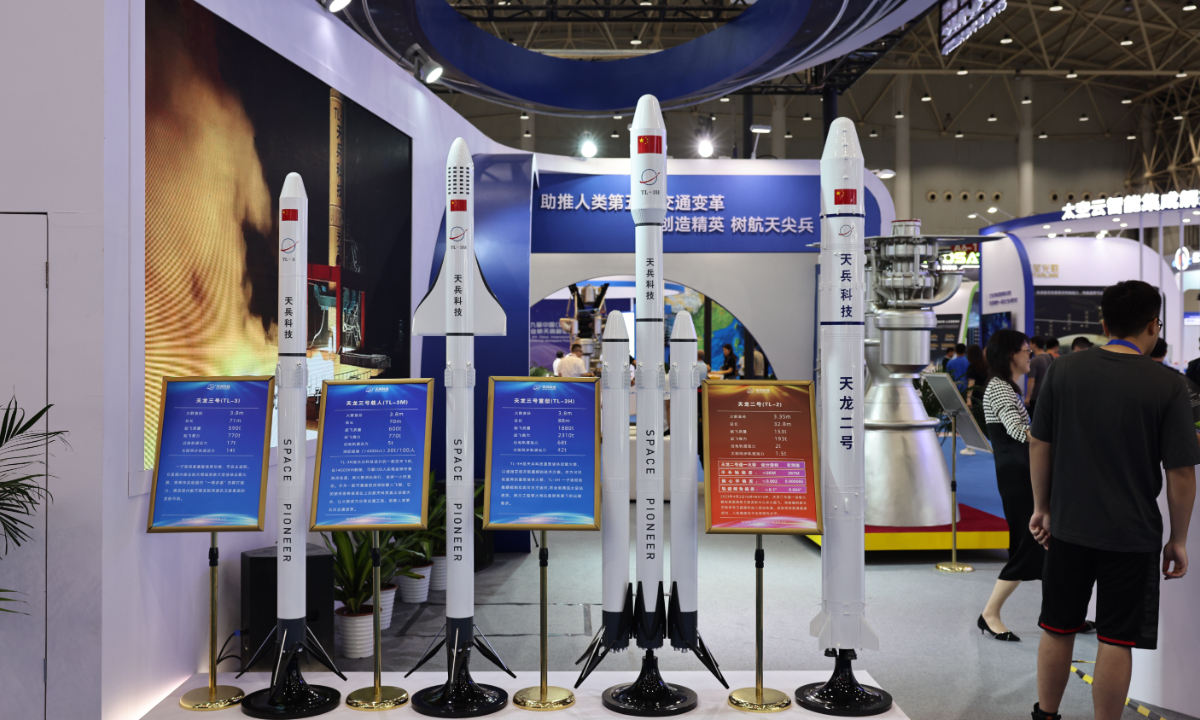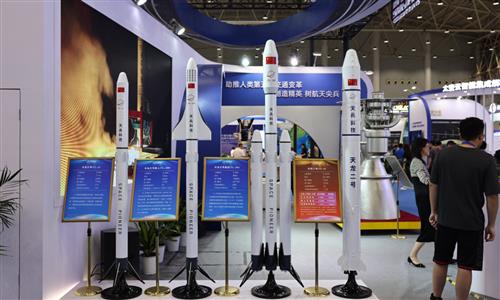Chinese 'Falcon 9 equivalent' rocket accident 'a rookie mistake'
Unlikely to have major impact on industry, but serves as a warning bell for peers: experts

Rockets and rocket engines on display in Wuhan on Wednesday Photo: Deng Xiaoci/GT
The unexpected take-off and crash of the Chinese "Falcon 9 equivalent" carrier rocket during what was supposed to be a static fire test was a "rookie mistake," and it won't have a significant impact on the country's commercial space industry, but will serve as a warning bell for peers to ensure safer operations in the future, space observers told the Global Times on Thursday.
Space Pioneer, China's leading private rocket firm, issued an apology on Tuesday afternoon for the failed test of its reusable rocket model, Tianlong-3, which was accidentally fired into the sky from its launch pad on June 30, due to "structural failure at the connection point." It then fell back to Earth and burst into flames in a mountainous area near the city of Gongyi, Central China's Henan Province, home to some 803,000 people.
The accident was recorded and posted on Chinese social media platforms by many local residents of Gongyi, many of whom shot the scene from their homes, suggesting how near they were to the scene of the crash. Witnesses near the scene told media that the explosion "created a deafening noise, with shockwaves shattering glasses," adding that it was "a frightening experience."
Fortunately, the test site is located far from the urban area of Gongyi, and surrounding personnel had been evacuated in advance, so no casualties were reported after investigation, the company said.
According to media reports, nine engines of the Tianlong-3 rocket were ignited simultaneously during the test, generating a thrust of 820 tons. This marked the highest thrust achieved in all China's current carrier rocket, doubling the maximum thrust tested in previous endeavors.
"The thrust of the engine can be estimated, giving a clear reference for test design. In addition, a margin of several hundred tons should be added into the test stand, so that it can withstand forces of at least 1,200 tons to ensure reliable testing," Wang Yanan, chief editor of Beijing-based Aerospace Knowledge magazine, told the Global Times on Thursday.
Moving from design to the implementation phase, Wang said a comprehensive assessment must be conducted to check that the equipment is usable, whether it has aged and that all components are in working order.
"Judging from these aspects, the cause of Tianlong-3 accident could be that the fastening device may have insufficient margin, or the construction and installation of the fastening device itself may have loopholes. Or the connection point - the choice of load-bearing parts - may be misjudged," Wang noted.
Tianlong-3 is a large liquid-fueled launch vehicle tailored for the construction of China's satellite internet constellation, with performance "comparable to SpaceX's Falcon 9." It has a diameter of 3.8 meters, a liftoff mass of 590 tons, a low Earth orbit (LEO) payload capacity of 17 tons and a sun-synchronous orbit (SSO) payload capacity of 14 tons.
If this test had been successful, the orbital debut would be scheduled for September this year, media reports said.
In a "2024 Global Unicorn List" released by the Hurun Research Institute, Space Pioneer ranked 495th globally and topping the list of commercial aerospace companies in China.
Since its establishment in 2019, Space Pioneer has completed 15 rounds of financing, with a total financing amount exceeding 4 billion yuan ($550 million), and its valuation has exceeded 12 billion yuan.
The recent accident has pushed the country's private commercial aerospace sector into the spotlight, with many expressing concerns about the future prospects of this thriving industry.
Addressing these concerns, experts said that while in the short term this will impact the company, or even the industry, it will definitely not be "a heavy blow."
"Fortunately, there were no casualties, and the economic losses can be remedied. More importantly, this will serve as a serious warning for the current private aerospace industry. If companies can learn from this lesson, then it can actually be beneficial for their future development," Wang noted.
Currently, there is a lot of passion for commercial spaceflights in China, and therefore more businesses are emerging in various localities. However, this incident reminds us that safety should always be the priority. Risk prediction and emergency response strategies are essential for safe operation, and careful consideration must be given to the selection of locations for ground tests, far away from urban areas, Wang said.

